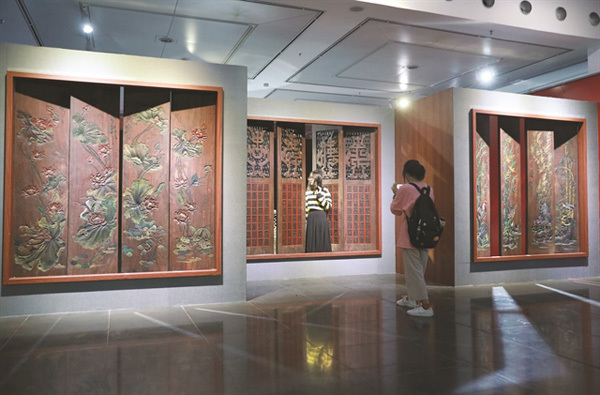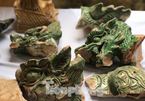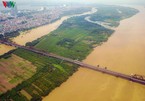Da said with a nearly 10,000sq.m area to fill, the museum has selected more than 70,000 objects and materials on the history of Thang Long – Hanoi.
 |
| The museum has received millions of visitors in the past ten years. |
“This will be a diversified story on history with a larger amount of objects and materials than any other museum in the country,” he said.
Da said the museum will feature the topic in both a chronicle exhibition and special topic display.
The collection will be divided into seven big themes, which include 25 minor topics like Nature, Journey to Thang Long, Thang Long Citadel in Dai Viet Era, Hanoi in 19th Century and early 20th century, Revolution and Independence (1873-1954), War against the Americans (1954-1975), Building Socialism and Hanoi on the Way to Renewal.
Each theme is demonstrated by various minor topics with a unique approach, like a new way to look on Hanoi with Giang Vo Martial Arts School, Vauban Citadel, Colonial City and Living Quarters in the City, Da said.
In the garden outside the museum, reflections of the Old Quarter, village’s gates, rural schools and steam engines will be on display.
The museum will invest in hi-tech searching devices allowing people to learn more about the city’s economy, politics, history, culture, geology and science.
Nearly 100 short clips on the history of Hanoi will be available in various languages.
“In our museum, the objects will tell the stories they experience with deeper and more profound characteristics than those in other museums,” he said.
Prof Nguyen Van Huy, deputy director of Centre for Cultural Heritage Research and Development, said the museum leaders worked with experts to change the normal way of exhibiting.
“I hope the new way in exhibiting applied in the museum will satisfy local audiences and tourists,” Huy said.
Searching for objects
In the past 10 years since its establishment, staff in the museum have travelled throughout the country to collect objects and donations of objects to the museum.
Quach Van Dich, a resident in Long Bien District, has donated an ancient anchor dating back 600 years to the museum.
According to Da, the anchor proves that in the past the Hong (Red) River received bog trading ships from abroad.
From the size of the anchor, people can imagine the size of the river at that time and compare with it the present, he said.
“Without the anchor, the story dubbed 'A Nostalgia to Hong River' would not be persuasive enough,” Da said.
Da met Dich three times to persuade him to donate the anchor to the museum.
Da also recalled collecting carved wooden pieces in Chu Quyen Communal House in Ba Vi District in the western outskirts of Hanoi.
“At first, elders in the village did not agree to give them to us,’ he said. “While the pieces were kept in a humid storehouse and had suffered mould and been eaten by termites.”
The carving patterns feature Mother Goddess worship with priceless flying horses, he said.
Finally, the museum decided to invite the village’s elders to attend a donation ceremony and see how the objects would be kept and displayed in the museum.
“They agreed to hand us the carving patterns after seeing how we take care of the objects,” he said.
Da said there have been many other interesting stories in the collection of objects like the steam engine in Gia Lam Train Factory and the steel bar to keep people from the railway at Ha Ninh Railway Company in the northern province of Nam Dinh.
Da said the staff are sparing no efforts to open the exhibition in June next year.
 |
| The museum seen from Pham Hung Road. VNS Photos Truong Vi |
The museum, established in 1982 and originally located in 5B, Ham Long Street, Hoan Kiem District, has hosted thousands of objects on Hanoi.
Its collection include stone, bronze, ceramic objects dating back to the Ly (1009-1225), Tran (1225-1400), Le (1428-1527) and Nguyen (1802-1945) dynasties and ancient imported ceramic from China and Japan.
In 2010, the city built a new premises for the museum near the National Conventional Centre in Nam Tu Liem District.
The whole museum is located in a total area of 54.000 sq.m.
The museum was opened on October 6, 2010 and has hosted various exhibitions and events. VNS

Historical artefacts discovered during Thang Long Citadel excavation
Many historical artefacts have been found during the excavation of Thang Long Citadel in Hanoi.

Traces of Red River civilization in Thang Long culture
The Red River has played a critical role in the historical and cultural life of Hanoi, Vietnam’s 1000-year-old capital.
 Hanoi Museum, is gathering objects to prepare for its most profound permanent exhibition ever, according to Nguyen Tien Da, director of the museum.
Hanoi Museum, is gathering objects to prepare for its most profound permanent exhibition ever, according to Nguyen Tien Da, director of the museum.